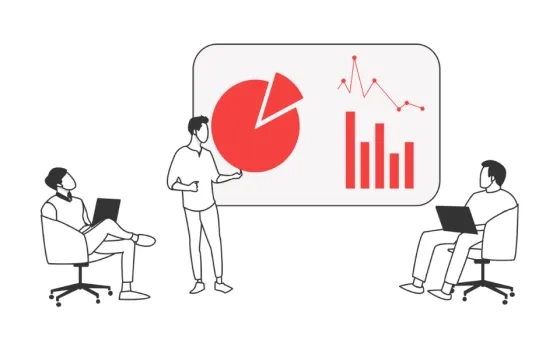Saas Design is all about making bold choices, thinking outside the box, and delivering a unique user experience. But what does that mean for Saas designers?
While having a solid UI/UX can help you stand out from the competition, having a weak UI/UX will likely result in your application being quickly forgotten.
The benefits of the SaaS model over alternative delivery formats are very evident – cloud storage, cost predictability and flexibility, on-demand scaling, and more. But these advantages can come at a price if not managed well, leading to a more complex user interface.
In this blog post, we’ll help you identify these challenges, discover solutions, and introduce you to the prevailing ideas in UI/UX and SaaS.
Design Challenges With SaaS Products
1. Relevant features
The most challenging aspects of working on SaaS interface design are deciding which functionalities to maintain and which to discard. Prioritizing features requires careful consideration of product competency. Designers of SaaS products often deal with this. They need to comprehend the relationship between different functionalities and how one feature might affect another.
Based on expert opinions and user feedback, some features are dropped to make space for newer and more relevant ones. That’s why you must have a feedback system so the design team can consider feedback and improve the interface design.
2. Issues with SaaS modelling
Users shouldn’t be kept out of the creative process. Screening and questioning are, therefore, essential. Unfortunately, the absence of extensive evaluation in the initial production phases is one of the most frequent errors while developing a SaaS model. The tool’s future usefulness cannot be determined by looking at a static UI prototype. As a result, you risk picking the wrong approach and failing.
Create a prototype that can be explored to solve this problem. For instance, you can check if the user experience is seamless and if all features function as intended. Simulate key scenarios to see if the interface is both productive and engaging.
SaaS prototypes are not easy to design, but they are worth the investment. Thorough testing in the early stages will save you time and money down the road.
3. Complex interfaces
The number of features and integrations in a SaaS product can quickly lead to a complex interface. The challenge for designers is to create an interface that is both sophisticated and user-friendly.
The key is to focus on the core features and design around them. Everything else should be secondary. Then, once the core features are in place, you can add in the bells and whistles.
It’s also essential to keep the interface consistent across all devices. A complex interface that is not responsive will only frustrate users and cause them to abandon the product. Users must be able to make judgments and explore with ease right away. It may be done by organizing information into categories, emphasising the fundamentals, and allowing users to go further if necessary.
Guidelines For Saas Design From UI/UX Experts
Users will never overlook subpar-quality elements. Your Saas application’s UI/UX elements are crucial and shouldn’t be undervalued. The immediate impression your tool makes is down to its interface design. An intuitive, easy-to-use, and visually appealing interface sets successful Saas applications apart from the rest. Here are some guidelines from experts in the field to help you create a top-notch Saas application.
1. Offering distinct value
Before you begin creating your Saas app, you must fully comprehend the concept behind your product, how it will feel, and what its features will be. You must also be mindful of your target users, why they want to use your solution, and what will be required to facilitate their achievement.
Always consider that you want to design a unique UI/UX that people in the future will like, desire to use frequently, and share with others.
2. Thematic colours
Even the most talented UI/UX designers can’t produce a SaaS design that resonates with every user equally. You must demonstrate to your user base that you appreciate their individual preferences and interests by providing them with a wide range of customization choices.
Allow for various letter sizes, and ensure that you can make bright colours darker. Additionally, stay within the platform’s defined colour palette and refrain from utilizing too many colours. Adjust the saturation when you wish to highlight a distinction in a category.
3. Pagination
Pagination is a scrolling method that divides digital content into separate pages, making it more digestible for the user. It’s one of the most basic elements of any SaaS interface, which is why it’s so important to get it right.
Pagination should be more varied to provide users with a better experience. For example, ditch the “next” and “previous” buttons in favour of something more creative and user-friendly, such as an infinite scroll or a load more button.
4. Keeping it simple
SaaS user interface design is a very labour-intensive process. It’s important to remember that you’re not designing for yourself but the user. The best way to achieve this is by keeping things simple and avoiding clutter.
Avoid using too many colours, fonts, or icons. Instead, use whitespace to your advantage, and ensure your content is well-organized and easy to scan. Simplicity will help your users focus on the task and avoid becoming overwhelmed.
5. Implementing dynamic sorting
It wouldn’t be ideal if you searched for something and were presented with many options that didn’t match what you were looking for, right? This is why implementing dynamic sorting is essential for any SaaS application. Users only view the information they need when specific filters narrow down their queries.
This will declutter the interface and make it more user-friendly. Additionally, it’ll save users time by allowing them to find what they’re looking for more quickly and easily.
6. Release, test, and enhance
When your Saas tool is ready for release, it is time to test it internally before public release. If the interface is bug-free and functioning well, you may launch it and turn the initial consumers into testers.
After launch, track user behaviour and feedback to enhance the interface continuously. New features should also be added regularly to keep users engaged.
Latest Trends In Saas UI/UX Design For 2022
The SaaS business is dynamic and evolving to fulfil the demands of contemporary users. As a result, your product must incorporate an increasing number of design trends. The following are a few instances of the newest trends for 2022:
1. Massive headings
The use of gigantic headlines can be a superb complement to the straightforward layout and neutral colours. They draw users’ attention to the most critical information.
Utilize a visual hierarchy by placing the most critical information in the biggest font and the less important information in smaller headers.
2. Scrollytelling
Scrolling is a novel approach to storytelling that engages users more interactively. Users already swipe through on their phones daily, making them familiar with this pattern.
When executed correctly, scrollytelling can pique the user’s curiosity and keep them engaged. It also allows you to present a lot of information in an easily digestible format.
3. Illustrations and graphics
Your SaaS product is not just made attractive by graphics and pictures. They make it credible and pertinent. You make it easier for the consumer to absorb the information, especially if it is data-heavy.
4. Minimalism
One of the best pieces of advice for your SaaS project design is to pick a few colours and a minimalistic theme. Select one or two essential hues that best represent your company.
Applying a minimalistic approach to your product will make it look modern and sleek. It will also declutter the interface and make it more user-friendly.
Examples of the Best UI SaaS Design
We’ve gathered a few SaaS UI design examples that will serve as a healthy dose of inspiration for your upcoming project to show how adaptable great UI/UX design can be. The examples in this list all feature successful UI designs that pique users’ interest while keeping usability at the forefront.
1. The card design from Dribbble
Dribbble employs cards to present the plethora of original and creative projects that designers contribute to the website daily, giving the viewer a bright and aesthetically pleasing overview.
2. Responsive colour scheme of Dropbox
The website for Dropbox is a terrific illustration of how responsive design is an excellent method to keep customers interested as they use your SaaS. In addition, you’ll go on a discovery voyage as you browse the site since each page appears to have a distinct colour scheme.
3. The colour gradients on Spotify
With an extensive music library, well-known company Spotify has shown skilful use of colour gradients that make the tool even more enjoyable.
Saas UI/UX Design: Concluding Remarks
The SaaS UI/UX design dramatically influences the brand’s success. If designed and performed correctly, it helps to lower customer churn rates, enhance the user experience, and increase customer satisfaction.
There is no one method for designing SaaS products. Every project is different, so come up with your strategy to make it stand out. However, we hope our list of SaaS UI/UX best practices has given you an understanding of the main trends and features to consider.



















